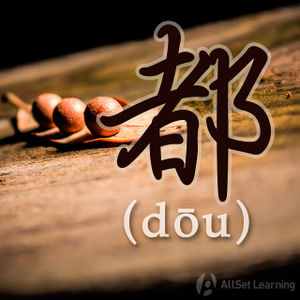Difference between revisions of "The "all" adverb "dou""
| Line 12: | Line 12: | ||
</div> | </div> | ||
| − | Remember that 都 appears ''after'' the subject. A common mistake learners make is to put 都 at the beginning of the sentence (as "all" often appears there in English). This isn't good Chinese - make sure you put 都 after the subject. | + | Remember that 都 (dōu) appears ''after'' the subject. A common mistake learners make is to put 都 (dōu) at the beginning of the sentence (as "all" often appears there in English). This isn't good Chinese - make sure you put 都 (dōu) after the subject. |
=== Examples === | === Examples === | ||
| Line 33: | Line 33: | ||
== 都 for "both" == | == 都 for "both" == | ||
| − | Chinese doesn't normally use a special word for "both" like English does. It just uses 都 as if it were any other number greater than one. This is actually really easy; you just have to get used to it. | + | Chinese doesn't normally use a special word for "both" like English does. It just uses 都 (dōu) as if it were any other number greater than one. This is actually really easy; you just have to get used to it. |
=== Structure === | === Structure === | ||
| Line 47: | Line 47: | ||
=== Examples === | === Examples === | ||
| − | These examples follow exactly the same form in Chinese as the ones above. The only difference is that we don't translate 都 as "all" for these in ''English''; we translate it as "both," and for negative cases, we translate it as "neither." | + | These examples follow exactly the same form in Chinese as the ones above. The only difference is that we don't translate 都 (dōu) as "all" for these in ''English''; we translate it as "both," and for negative cases, we translate it as "neither." |
<div class="liju"> | <div class="liju"> | ||
Revision as of 03:23, 15 October 2014
-
Level
-
Similar to
-
Used for
-
Keywords
The adverb 都 (dōu) is used to express "all" in Chinese. It's very common to use 都 (dōu) in all sorts of sentences where we would find it unnecessary in English.
Contents
都 for "all"
Structure
Subject + 都 + [Verb Phrase]
Remember that 都 (dōu) appears after the subject. A common mistake learners make is to put 都 (dōu) at the beginning of the sentence (as "all" often appears there in English). This isn't good Chinese - make sure you put 都 (dōu) after the subject.
Examples
- 我们 都 爱 你 。 We all love you.
- 你们 都 学 中文 吗 ? Do you all study Chinese?
- 你们 都 认识 John 吗 ? Do you all know John?
- 我们 都 在 上海 。 We are all in Shanghai.
- 我们 都 可以 去 吗 ? Can we all go?
- 他们 都 踢 足球 。 They all play soccer.
- 我 和 我 父母 都 在 这里 。 My parents and I are all here.
- 你们 都 用 wiki 吗 ? Do you all use the wiki?
- 你们 都 喜欢 喝 咖啡 吗 ? Do you all like drinking coffee?
- 你们 都 要 冰 啤酒 吗 ? Do you all want a cold beer?
都 for "both"
Chinese doesn't normally use a special word for "both" like English does. It just uses 都 (dōu) as if it were any other number greater than one. This is actually really easy; you just have to get used to it.
Structure
[Subject which is two people or things ] + 都 + [Verb Phrase]
This pattern should look familiar!
Examples
These examples follow exactly the same form in Chinese as the ones above. The only difference is that we don't translate 都 (dōu) as "all" for these in English; we translate it as "both," and for negative cases, we translate it as "neither."
- 我们 两 个 都 爱 你 。 The two of us both love you.
- 你们 两 个 都 学 中文 吗 ? Do you both study Chinese?
- 我 和 我 老公 都 是 美国 人 。 My husband and I are both Americans.
- 我 和 我 太太 都 在 上海。 My wife and I are both in Shanghai.
- 我 和 他 都 喜欢 中国 菜 。 He and I both like Chinese food.
- 你 爸爸 和 妈妈 都 是 中国 人 吗? Are your mom and dad both Chinese?
- 我 和 我 男朋友 都 不 想 工作。 Neither my boyfriend nor I want to work.
- 我 的 儿子 和 女儿 都 不 吃 肉。 Neither my son nor my daughter eat meat.
- 他们 两 个 都 不 喝 酒。 Neither of the two of them drink alcohol.
- 你们 两 个 都 不 可以 走。 Neither of you two may leave.



